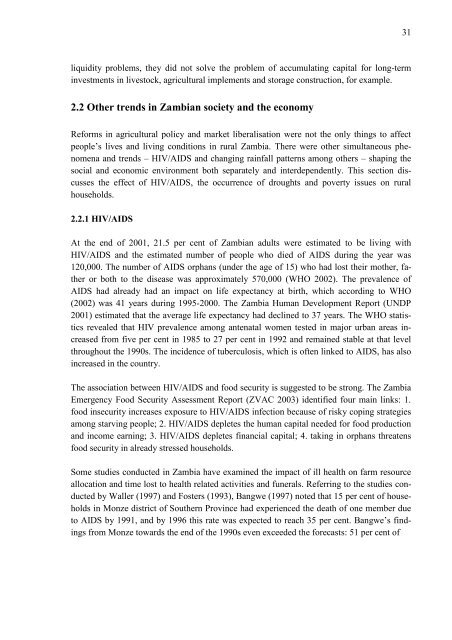Rural Income Generation and Diversification - A Case Study ... - Doria
Rural Income Generation and Diversification - A Case Study ... - Doria
Rural Income Generation and Diversification - A Case Study ... - Doria
You also want an ePaper? Increase the reach of your titles
YUMPU automatically turns print PDFs into web optimized ePapers that Google loves.
liquidity problems, they did not solve the problem of accumulating capital for long-term<br />
investments in livestock, agricultural implements <strong>and</strong> storage construction, for example.<br />
2.2 Other trends in Zambian society <strong>and</strong> the economy<br />
Reforms in agricultural policy <strong>and</strong> market liberalisation were not the only things to affect<br />
people’s lives <strong>and</strong> living conditions in rural Zambia. There were other simultaneous phenomena<br />
<strong>and</strong> trends – HIV/AIDS <strong>and</strong> changing rainfall patterns among others – shaping the<br />
social <strong>and</strong> economic environment both separately <strong>and</strong> interdependently. This section discusses<br />
the effect of HIV/AIDS, the occurrence of droughts <strong>and</strong> poverty issues on rural<br />
households.<br />
2.2.1 HIV/AIDS<br />
At the end of 2001, 21.5 per cent of Zambian adults were estimated to be living with<br />
HIV/AIDS <strong>and</strong> the estimated number of people who died of AIDS during the year was<br />
120,000. The number of AIDS orphans (under the age of 15) who had lost their mother, father<br />
or both to the disease was approximately 570,000 (WHO 2002). The prevalence of<br />
AIDS had already had an impact on life expectancy at birth, which according to WHO<br />
(2002) was 41 years during 1995-2000. The Zambia Human Development Report (UNDP<br />
2001) estimated that the average life expectancy had declined to 37 years. The WHO statistics<br />
revealed that HIV prevalence among antenatal women tested in major urban areas increased<br />
from five per cent in 1985 to 27 per cent in 1992 <strong>and</strong> remained stable at that level<br />
throughout the 1990s. The incidence of tuberculosis, which is often linked to AIDS, has also<br />
increased in the country.<br />
The association between HIV/AIDS <strong>and</strong> food security is suggested to be strong. The Zambia<br />
Emergency Food Security Assessment Report (ZVAC 2003) identified four main links: 1.<br />
food insecurity increases exposure to HIV/AIDS infection because of risky coping strategies<br />
among starving people; 2. HIV/AIDS depletes the human capital needed for food production<br />
<strong>and</strong> income earning; 3. HIV/AIDS depletes financial capital; 4. taking in orphans threatens<br />
food security in already stressed households.<br />
Some studies conducted in Zambia have examined the impact of ill health on farm resource<br />
allocation <strong>and</strong> time lost to health related activities <strong>and</strong> funerals. Referring to the studies conducted<br />
by Waller (1997) <strong>and</strong> Fosters (1993), Bangwe (1997) noted that 15 per cent of households<br />
in Monze district of Southern Province had experienced the death of one member due<br />
to AIDS by 1991, <strong>and</strong> by 1996 this rate was expected to reach 35 per cent. Bangwe’s findings<br />
from Monze towards the end of the 1990s even exceeded the forecasts: 51 per cent of<br />
31

















